How to hybridize zinnias -- it's easy.
I am a zinnia hobbyist, and enjoy breeding my zinnias. If you have some zinnias, it is relatively easy to hybridize them yourself. The pollen florets (fuzzy yellow starfish) have the pollen, and the stigmas (Y-shaped tendrils) receive the pollen. (Click on these pictures to see larger versions of them.)
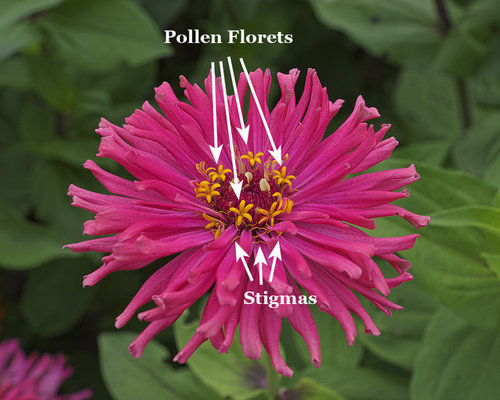
There are several ways to transfer the pollen from Pollen Florets to Stigmas. One way is to use an artist's brush. Simply dip the brush into the pollen at the center of a newly opened pollen floret (they open in the morning -- the exact time depending on local weather conditions).




A stigma will remain yelllow and receptive for a week to 10 days, so you have multiple opportunities to get it pollinated. When the Stigmas you have pollinated shrivel and die, they are no longer receptive, but that could mean that your pollination was successful and a seed is developing an embryo inside the seed at the base of the petal.
Remember which zinnias you have pollinated and save seeds from them. I don't depend on my memory, so I attach a label to the stem of the blooms that I pollinate.
Zinnia seeds are relatively large and easy to handle, so that is another advantage to working with them. I store my zinnia seeds in Ziploc snack size bags, along with a 3x5 card containing some information about the seeds.
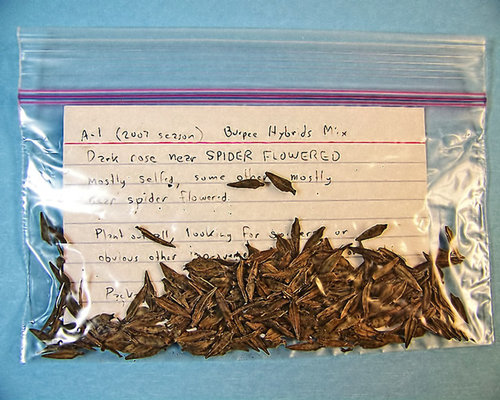
I just want to emphasize that it is easy to hybridize your zinnias. And you never know what you will get when your home hybrids start to bloom for the first time. I still enjoy that first-bloom anticipation after countless times.
ZM (not associated with any product or vendor mentioned)
Comments (17)
- 7 years ago
Hi Zen,
I've decided I want to experiment with my zinnias. I only have 3 varieties currently blooming: Uproar rose, Envy and Zinderella. I have a favorite uproar plant. It gives me at least 4" zinnias while the other uproars are not as big and vibrant. So I decided to use this one. Now, none of the zinderellas turned out to be scabious, which is what I wanted. If I tried crossing the two is it still possible to get the scabious trait or am I reaching?I can't really imagine what kind of frankenzinnia I'd get crossing those two since they are both hybrids. I imagine with Envy being open pollinated I'll get something more consistant? I have other varieties growing but none are flowering yet. So I only have those three.
Also, at what point do I cover the flower and do I have to leave the flower on the plant until it browns all the way? Will that stop the plant from making more flowers? It's the nicest plant so I'd hate to put it to rest so soon.
zen_man
Original Author7 years agolast modified: 7 years agoHi 123,
" If I tried crossing the two is it still possible to get the scabious trait or am I reaching? "
I think your non-scabious Zinderellas are a lost cause. At least, from the standpoint of "scabiosity". I have to admit, as expensive as their seed is, I am genuinely surprised at how bad they have been turning out for pretty much everybody who has grown them. But my experience with other scabious zinnias is only about one in twenty is "good". You have to grow a lot of them to have any success with them.
" I can't really imagine what kind of frankenzinnia I'd get crossing those two since they are both hybrids. "
Zinderellas are probably not an F1 hybrid, but just had some hybridization in their origin. Uproar is an F1 hybrid, and should be very uniform for that reason. I grew some one year, and was very impressed how identical my specimens were. But, to me, they were just medium purple dahlia flowered zinnias. I thought it was a bit of a stretch referring to their color as "rose". Incidentally, making hybrids between hybrids is a good technique for getting interesting new zinnias. The only time I had a zinnia that I would refer to as a "frankenzinnia" was one that was suffering badly from a weird disease called Aster yellows Its "flower" consisted in a bunch on apparent zinnia plants growing out of a central growth.
You are in Zone 9 in Texas with a lot of growing season left. Zinnias bloom in about 6 weeks from seed. I am still planting some zinnias outside here in Kansas, and I have a lot less growing season than you have. I will be planting zinnias up until about the Fourth of July. You have time to "start over" and buy some different zinnia seed. I always recommend Whirligigs as one component of a zinnia breeding project. And I always grow some Burpeeana Giants because they have big blooms on nice bushes. And both of those strains have a mix of colors. If I am growing a separate color, white is my favorite for mixing with other colors. Envy is OK as a green zinnia -- it is an old heirloom. There are newer greens -- I particularly like Burpee's Tequila Lime. It looks like it has been crossed with a white.
There are several hybrids of greens with other colors available, but none of them appeal to me. But that is a matter of personal taste, and a lot of people may just love them. I don't know how much space you have available, but there are a lot of zinnia varieties available. Check out the zinnia offerings from Hazzard's Seeds There is a second page to that link.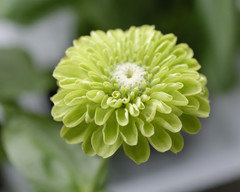
" Also, at what point do I cover the flower and do I have to leave the flower on the plant until it browns all the way? "
You don't need to cover the flower and you can harvest plump green seeds in about three weeks after pollinating them.
" Will that stop the plant from making more flowers? "
As long as your plant has enough water and nutrients it should continue to develop new blooms.
I welcome your comments and questions. I lived in Fort Worth for many years, and I remember one Christmas when I realized my zinnias hadn't experienced a killing freeze yet. They did have a lot of Powdery Mildew, though.
ZM (not associated with any product or vendor mentioned or linked)
Related Professionals
Windham Landscape Architects & Landscape Designers · Ferndale Landscape Architects & Landscape Designers · Kapaa Landscape Architects & Landscape Designers · Mitchellville Landscape Architects & Landscape Designers · Cockeysville Landscape Contractors · Galveston Landscape Contractors · Marlborough Landscape Contractors · Midland Landscape Contractors · Sugar Hill Landscape Contractors · Wayland Landscape Contractors · Miller Place Carpenters · Clarksburg Fence Contractors · Lincolnwood Fence Contractors · Saint Louis Park Fence Contractors · Sunrise Manor Fence Contractors- 7 years ago
Thank you zen,
I have have tequila lime waiting to germinate and sadly some left over zinderellas to try my luck again. I have Polar bear waiting to bloom and hidden dragon waiting to bloom and I forgot I also have some sahara starlights I bought on a whim as plants. I had a problem with powdery mildew mid texas spring and I wasn't sure if neem oil would suffice so did a lot of de-leafing and pruning and they came back and seem happy. I grow them for bouquets so this will be interesting. What is the closest you reccommend planting them. My space is limited so I have to fit as close as possible, but I think I may have crowded the ones I have too much and that contributed to the powdery mildew.
0 zen_man
Original Author7 years agoHi 123,
" What is the closest you reccommend planting them. My space is limited so I have to fit as close as possible... "
You can plant the seeds a few inches apart, but as they develop a few leaves you should thin them to 12 inches or more apart. I know I am going to do a severe cull at first bloom, so I take that into account. and plant rather close together.
" I had a problem with powdery mildew mid texas spring... "
You can prevent Powdery Mildew in zinnias with a good systemic fungicide. You mentioned Neem Oil -- does that mean you are an organic gardener? If so, that eliminates a systemic fungicide, but you might find a product based on potassium bicarbonate (such as Green Cure) to be helpful. I am not an organic gardener, so I use a systemic fungicide on my favorite breeder zinnias.
" ...some left over zinderellas to try my luck again. "
You could plant them just a few inches apart, knowing that most of them will not be true-to-form scabious blooms, so you will be culling most of them.
ZM
0zen_man
Original Author7 years agoThey are not the same, but all three have bi-colored or tri-colored petals. Their plant height may also vary.
0- 6 years ago
Woah cool. i have zahara, persian carpet, lilliput, and trying for dwarf thumbelina (still in seed form, never had a chance for sowing and growing them) one of my zinnia (now dead) bloomed and its really pretty! It took a really long time for the full bloomed zinnia to dry with fully formed seeds, Around 1 month so i can harvest seeds. I never pollinate them, is that why? Should i hand-pollinate them so they can seed faster?
0 zen_man
Original Author6 years agoHi Whirly,
" i have zahara, persian carpet, lilliput, and trying for dwarf thumbelina (still in seed form, "
You have three different species of zinnias in that small selection. The Zaharas are a 46-chromosome man-made species, Zinnia marylandica. The Persian Carpets are 24-chromosome Zinnia haageana. The Lilliputs and Thumbelinas are 24-chromosome Zinnia elegans (now referred to in academic circles as Zinnia violacea, after the wild species from which they were derived.
" It took a really long time for the full bloomed zinnia to dry with fully formed seeds. "
If you had been following the "It can be fun to breed your own zinnias" threads over in the Annuals forum, you would know that it is actually preferable to gather zinnia seeds in the green state. It takes only about three weeks for a zinnia embryo to develop to a matured stage, and the seeds are still green, with the attached petals fully alive and with color at that time. The quicker you gather the seed, the less chance seed-eating birds, like finches, have to eat them. And brown mature seeds in a brown seedhead are susceptible to pre-germination in the head if you have a rainy spell.
" Around 1 month so i can harvest seeds. I never pollinate them, is that why? "
No, your pollinating or not pollinating them only affects the number of viable seeds that you get.
" Should i hand-pollinate them so they can seed faster? "
You should hand pollinate them so you will get more viable seeds. And, if you do hand pollinate them, you have the opportunity to make hybrids of your own choice. You can get some interesting results by making your own zinnia hybrids.
ZM
- 6 years ago
I like zinnias and might try this someday but my main interest is in hybridizing roses. I have grown open pollinated rose seeds for years and enjoy seeing what I get. Some are garden worthy. But I am daunted by the prospect of doing crosses. For one thing, my first attempt at that was to collect a lot of different anthers and wait for them to release their pollen. I got so little pollen it seemed not worth the bother. So my question for you is do you worry about how much pollen you have or do you just assume it'll be enough?
I need to simplify it as much as possible in order to start. My thinking is that I need to cross one rose with one other rose, and every hip on that plant will have the same parent plants. I'd just put a twist tie on each pollinated stem and not have to write everything out.
I like the idea of taking a blossom and using it as a paint brush for pollen, instead of removing the pollen and then brushing it on. Any ideas for simplification would be appreciated.
zen_man
Original Author6 years agoHello erasmus,
" So my question for you is do you worry about how much pollen you have or do you just assume it'll be enough? "
Zinnias can put out fresh pollen florets every morning, so that isn't a problem.
" Any ideas for simplification would be appreciated. "
I don't know enough about rose breeding to presume to tell you better ways to do it. Commercial rose breeders may consider some of their better techniques to be trade secrets.
" But I am daunted by the prospect of doing crosses. "
I am not the best person to be giving you advice on this. I have an ongoing indoor zinnia project, currently growing zinnias under lights.
 I can literally wake up in this coming morning in a few hours, and do several crosses before breakfast. Doing a single cross can take maybe a minute. It's kind of hard to get daunted over something that takes only 60 seconds. I will make several zinnia crosses tomorrow. I accept that your roses are not ready to be cross pollinated this coming morning. Just out of curiosity, when will they be ready?
I can literally wake up in this coming morning in a few hours, and do several crosses before breakfast. Doing a single cross can take maybe a minute. It's kind of hard to get daunted over something that takes only 60 seconds. I will make several zinnia crosses tomorrow. I accept that your roses are not ready to be cross pollinated this coming morning. Just out of curiosity, when will they be ready?
ZM
0zen_man
Original Author6 years agoHello erasmus,
That is a spectacular broken color rose. There are some patented varieties that are similar, so you did good.
" I don't have much time for that in spring so I think my own idea
about just crossing one rose with one other rose will help me avoid the
tedium of labeling each stem. "When I first started breeding zinnias many years ago, I tried labeling individual pollinated blooms with attached 3x5 cards with pertinent information written on the card. Besides being tedious, the 3x5 cards became damaged by rains, winds, and weathering in general. So I resolved to attach a minimum of information on the plants, and to do that in a weatherproof manner. I settled on assigning a three-character breeder code, consisting of a letter and two digits. I attached those breeder codes to the plants with weatherproof Velcro labels that I made. I wrote the codes on the Velcro labels with a black Sharpie.
I use a different beginning letter every year. This year I am using the letter "L".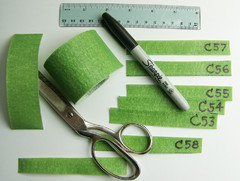 The Velcro labels attach easily and securely to the plants by rolling the end of the Velcro around a stem a few turns. The Velcro sticks to itself, in a waterproof weatherproof way, and can be unstuck easily if you want. The color of the Velcro label blends with the plant color. I record the detailed information associated with the code in a special notebook.
The Velcro labels attach easily and securely to the plants by rolling the end of the Velcro around a stem a few turns. The Velcro sticks to itself, in a waterproof weatherproof way, and can be unstuck easily if you want. The color of the Velcro label blends with the plant color. I record the detailed information associated with the code in a special notebook. A few years ago, an earlier notebook got severely damaged when I was caught out in the garden in a sudden rainstorm, so I now use a waterproof weatherproof notebook, similar to what the military use in field exercises. The notebook and the pages are waterproof. I write in soft lead pencil, which is also waterproof. You can literally write in such a notebook while out in the rain, if need be.
A few years ago, an earlier notebook got severely damaged when I was caught out in the garden in a sudden rainstorm, so I now use a waterproof weatherproof notebook, similar to what the military use in field exercises. The notebook and the pages are waterproof. I write in soft lead pencil, which is also waterproof. You can literally write in such a notebook while out in the rain, if need be.
This method lets me write the detailed stuff just once, in a secure portable place, and attach it with coded Velcro labels easily to as many plant stems as I need to. The Velcro labels with brief codes minimize what you need to attach to the plants. You might want to try something similar with your roses. I can supply specific details if you are curious.
ZM
0- 6 years ago
Zenman, Thanks! Little tips like that really can help. I like how the velcro you use is unobtrusive and would not look ugly in the garden. I guess the Sharpie marker you use holds up ok. It would not have to last a very long time. Usually I harvest rose hips in fall, so it would be just a matter of six months or so that they'd have to last. I have switched to an oil based paint pen for outdoor labels that I need to hold up longer.
I simply overwhelm myself with making doing crosses out to be super hard. I think if I start small it'll help .
I think many rose breeders in the past often used open pollinated hips but " selfs" are supposedly not as good as some crosses can be. I have some combinations in mind that would be fun to try anyway. Right now I have two flats of rose seedlings under lights, and I take them outside to be in the sun when it's warm enough.
Thanks re my striped rose. I named it after my mom...it's Fran's Pirouette. It makes a nice branchy shrub about 3.5 x 3.5' and reblooms. Is reasonably healthy. Here are a few other of my open pollinated seedlings:
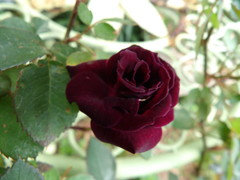 You can see it gets some blackspot. The parent plant is Louis XIV, an old rose with great rebloom and fragrance. It usually doesn't set hips so I was excited to get a seedling from it. The plant has good vigor. The blooms are smaller than Louis XIV. I named it after my late dog, Jack Daniel.
You can see it gets some blackspot. The parent plant is Louis XIV, an old rose with great rebloom and fragrance. It usually doesn't set hips so I was excited to get a seedling from it. The plant has good vigor. The blooms are smaller than Louis XIV. I named it after my late dog, Jack Daniel.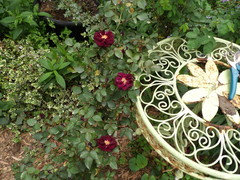
This one is Sunnyside Bob, named after my husband. Not the strongest plant but pretty and fragrant with good rebloom:
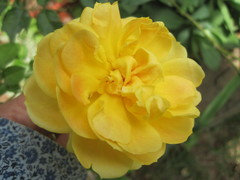
This is The Good Dog which is healthy and vigorous:
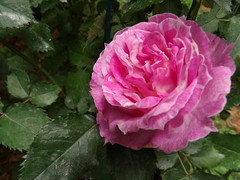
and one named after my daughter, Lauren Elizabeth. This one is powerfully fragrant, is probably a climber, repeats, has a ton of petals but "balls" or fails to open sometimes. It came from Climbing Crimson Glory, but my seedling has a lot more petals.
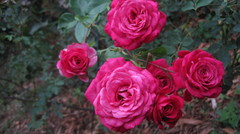
It is just fun. Always a surprise to see what you get. It's not hard to grow rose seeds. You just pick the hip, dig out the seeds which are pretty big, refrigerate them for a couple of months in damp paper towels, put those in plastic bags, then plant in Jan or Feb in seed starter mix.
I grew some gigantic zinnias last year...biggest I ever grew. Came from a pack of California Giants. I like some of the smaller flowered ones too and the green ones look worth a try. You have some interesting seedlings.
zen_man
Original Author6 years agoHi erasmus,
I think it is great that you named some of your roses after family members.
" I guess the Sharpie marker you use holds up ok. It would not have to
last a very long time. Usually I harvest rose hips in fall, so it
would be just a matter of six months or so that they'd have to last. "The Sharpie marker on Velcro has held up excellently. I guess that is because quite a bit of the black ink "soaks into" the Velcro. I have had Sharpie fade on metal row markers, and I think that is because the coating is so thin on the metal.
" I grew some gigantic zinnias last year...biggest I ever grew. Came from a pack of California Giants. "
About a year ago I realized that I wanted to improve my zinnia plants significantly, so I grew some California Giants because of their big plants. Their genes are gradually getting mixed into my gene pool. I am also wanting my zinnia plants to be more "refined," with longer narrower sharper pointed "un-zinnia-like" leaves. And to a limited extent so far, I have been achieving that.
I like to hybridize zinnias because they have such a fast development cycle, blooming in 6 to 8 weeks from seed. Some of my indoor zinnias have bloomed as soon as 5 weeks from seed. I am working on my second generation of zinnias in my ongoing indoor zinnia project. I am on-track to get four generations of zinnias this year. I also am pleased that I have made considerable progress getting new flower forms in zinnias. This is yet another new one that appeared a few weeks ago. I have been crossing it with several other unique zinnia flower forms. Its narrow tubular petals are reminiscent of an earlier "Starburst" zinnia flower form that I like.
I have been crossing it with several other unique zinnia flower forms. Its narrow tubular petals are reminiscent of an earlier "Starburst" zinnia flower form that I like. Tubular petals are involved in several of my new zinnia flower forms. Tomorrow is supposed to be warmer here, so I will probably do some preparatory work in my outdoors zinnia garden then. Our night-time lows are in the 20s, so I am not tempted to start any zinnias outdoors yet. But my indoor project is busy, busy.
Tubular petals are involved in several of my new zinnia flower forms. Tomorrow is supposed to be warmer here, so I will probably do some preparatory work in my outdoors zinnia garden then. Our night-time lows are in the 20s, so I am not tempted to start any zinnias outdoors yet. But my indoor project is busy, busy.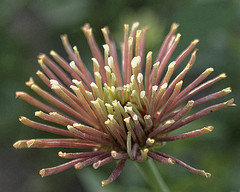
ZM
- 3 years ago
I would like to breed my own zinnia seeds, but I learned from the thread that it matters whether the parents are diploid, tetraploid, or triploid. I don't really want to produce a triploid. How do I know which are diploid and tetraploid? Specifically, what are cut and come again? Diploid?
0 - 2 years agolast modified: 2 years ago
Zen_man could I breed Zinnia Marylandica with Zinnia Elegans? Is that even a possibility? I want the colors of Marylandica Double Raspberry Ripple with the size of Barney's Giants, and I'd like to see some coloring similar to Queens Lime Red too. Would I need to have pollinate to make such a cross?
0






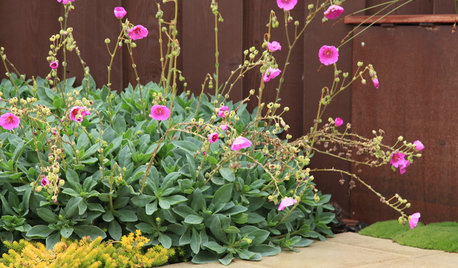


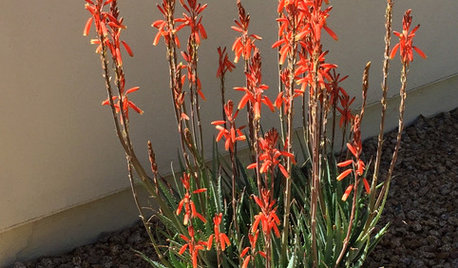



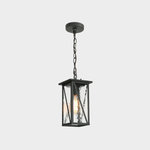


erasmus_gw